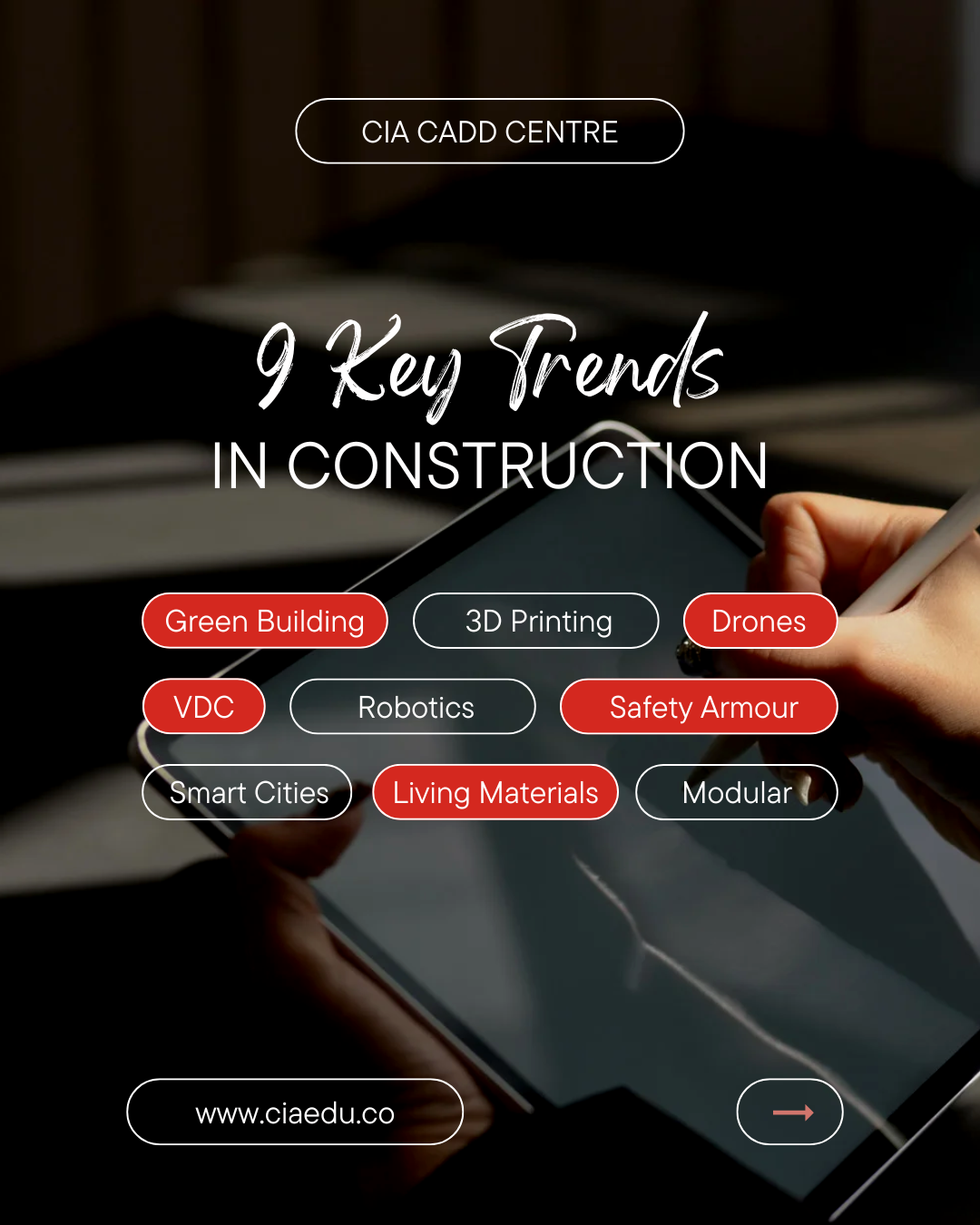
9 Key Trends in Construction
- Posted by admin
- Categories Latest News
- Date August 13, 2024
The Future of Construction: Key Trends and the Role of CAD
The construction industry is on the brink of a technological revolution, reshaping how buildings are designed, constructed, and maintained. From Virtual Design and Construction (VDC) to advanced robotics, innovations are driving efficiency, sustainability, and safety. At the heart of many of these advancements is Computer-Aided Design (CAD), which continues to be a crucial tool in modern construction practices. In this blog, we’ll explore the latest trends in the construction industry and highlight how CAD technology is playing a pivotal role in these advancements.
1. Virtual Design and Construction (VDC) and Building Information Modeling (BIM)
Virtual Design and Construction (VDC) and Building Information Modeling (BIM) are at the forefront of transforming construction processes. VDC uses CAD technology to create a digital representation of a building, encompassing all aspects of its design, from architectural to structural elements. BIM, a more comprehensive form of VDC, involves creating detailed 3D models that integrate data on every component of a project.
CAD software enables precise modeling and simulation, allowing stakeholders to visualize and analyze the construction process before breaking ground. This results in fewer errors, improved collaboration, and cost savings. By integrating BIM with CAD, construction professionals can streamline workflows, enhance project coordination, and ensure higher-quality outcomes.
2. Prefabrication and Modular Construction
Prefabrication and modular construction are gaining momentum as efficient alternatives to traditional building methods. These approaches involve manufacturing building components or entire modules off-site in controlled environments before transporting them to the construction site for assembly.
CAD plays a critical role in this process by facilitating precise design and manufacturing of prefabricated elements. Accurate CAD models ensure that components fit together seamlessly, reducing waste and construction time. By leveraging CAD in the design phase, prefabricated and modular projects benefit from enhanced accuracy and efficiency.
3. Smart Cities and the Internet of Things (IoT)
The concept of Smart Cities integrates technology to improve urban living conditions and infrastructure management. The Internet of Things (IoT) involves embedding sensors and smart devices into buildings and infrastructure to monitor and manage various systems in real-time.
CAD software supports the development of smart cities by enabling the design and simulation of connected infrastructure. For instance, CAD models can incorporate IoT systems to simulate and analyze how different sensors and devices will interact within a building or urban environment. This ensures that smart city designs are both functional and efficient, paving the way for more connected and sustainable urban spaces.
4. Green Building and Sustainable Design
Green building emphasizes environmentally responsible and resource-efficient construction practices. Incorporating sustainable materials and energy-efficient systems are key components of green building strategies.
CAD technology aids in green building design by allowing architects and engineers to model and analyze various environmental impacts. For example, CAD tools can simulate energy usage, daylighting, and thermal performance, helping designers make informed decisions that enhance sustainability. Additionally, CAD software can support the integration of green technologies, such as renewable energy systems and advanced HVAC solutions, into building designs.
5. Living Building Materials: Self-Replicating Concrete and Self-Mending Biocement
Living building materials, like self-replicating concrete and self-mending biocement, represent a groundbreaking shift in construction materials. These materials have the ability to repair and regenerate themselves, extending the lifespan of structures and reducing maintenance costs.
CAD technology supports the design and implementation of these advanced materials by providing detailed modeling and simulation capabilities. For example, CAD tools can be used to visualize how self-replicating concrete interacts with its environment or how biocement repairs cracks over time. This helps engineers and architects design structures that leverage these innovative materials effectively.
6. Drone Technology
Drones are revolutionizing construction site management, offering aerial views and real-time data collection. Drones can capture high-resolution images and videos of construction sites, which can then be integrated into CAD models for enhanced project monitoring and analysis.
By using drone technology in conjunction with CAD, construction professionals can gain valuable insights into site conditions, track progress, and identify potential issues early. This integration enhances accuracy and efficiency, contributing to more successful project outcomes.
7. Workers Armor and Safety Technology
The safety of construction workers is paramount, and innovations in workers’ armor and safety technology are playing a crucial role in protecting them. Modern safety gear includes smart helmets, wearable sensors, and augmented reality (AR) systems that provide real-time information and alerts.
CAD software aids in the design and development of these advanced safety systems by allowing engineers to model and test various features and configurations. This ensures that safety gear is both effective and comfortable, enhancing overall worker protection on construction sites.
8. 3D Printing
3D printing is making significant strides in construction, enabling the creation of complex building components and even entire structures using additive manufacturing techniques. This technology allows for rapid prototyping and customization, reducing material waste and construction time.
CAD plays a crucial role in 3D printing by providing the digital models needed for additive manufacturing. Accurate CAD designs ensure that 3D-printed components meet precise specifications, leading to more reliable and innovative construction solutions.
9. Construction Robotics
Construction robotics are transforming how buildings are constructed, with robots performing tasks ranging from bricklaying to concrete pouring. These technologies enhance precision, speed, and safety on construction sites.
CAD technology supports the development and integration of construction robots by providing detailed models and simulations. This helps engineers design robotic systems that can interact seamlessly with existing construction processes, leading to improved efficiency and reduced labor costs.
Conclusion
The construction industry is rapidly evolving, driven by technological advancements that enhance efficiency, sustainability, and safety. Computer-Aided Design (CAD) continues to be a foundational tool in this transformation, supporting innovations such as VDC, BIM, prefabrication, smart cities, green building, living materials, drone technology, and more.
By embracing these trends and leveraging the power of CAD, construction professionals can stay ahead of the curve, delivering higher-quality projects that meet the demands of a modern, connected world. For more insights into how CAD is shaping the future of construction, stay tuned to our blog!
Keywords: Computer-Aided Design, CAD, Virtual Design and Construction, VDC, Building Information Modeling, BIM, Prefabrication, Modular Construction, Smart Cities, IoT, Green Building, Sustainable Design, Living Building Materials, Self-Replicating Concrete, Self-Mending Biocement, Drone Technology, Workers Armor, Safety Technology, 3D Printing, Construction Robotics
Previous post



